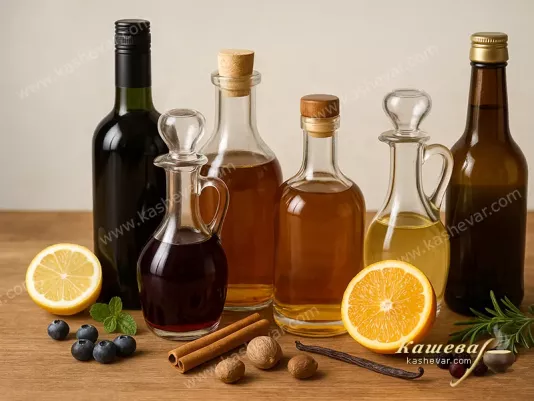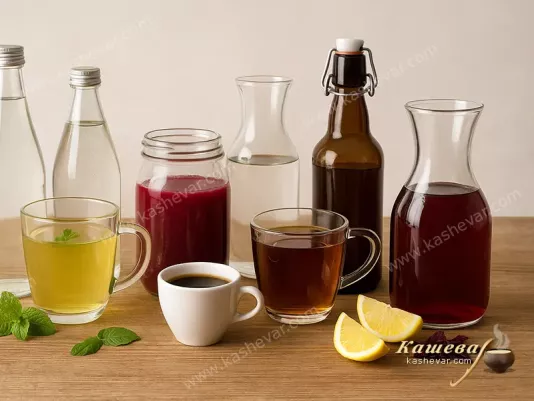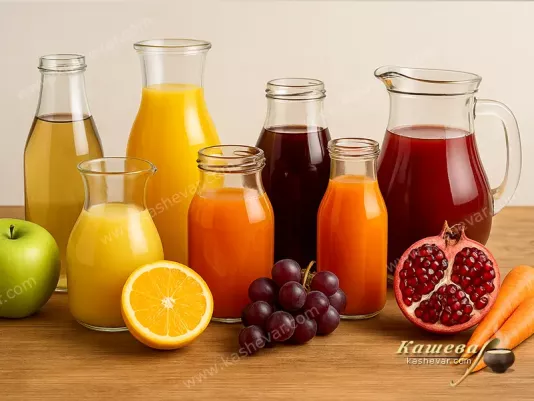Beverages
Drinks have always played a special role in my cooking, as they not only quench thirst but also become valuable ingredients for various dishes. I use alcoholic drinks to prepare sauces, marinades, desserts, and to enhance the taste of meat or fish. Wine, beer, spirits, and liqueurs in my experience open new culinary possibilities and make dishes more refined. Non-alcoholic drinks such as water, sparkling water, tea, coffee, or kvass I use daily: they help create dough, sauces, desserts, and cold soups. For me, this category combines traditions and modern ideas, as drinks add new shades to recipes and create a harmonious balance of flavors. I always consider them an essential part of the kitchen, which helps reveal a dish’s potential and make it unique.
Different Types of Drinks
Alcoholic Drinks
I have always used alcoholic drinks as ingredients capable of adding depth and expressiveness to dishes. Wine is a classic for me: I add white wine to sauces for fish or chicken, use red wine for stewing meat, and sparkling wine in desserts to make them lighter and more festive. Beer in my experience works wonderfully for bread or pancake batter, as well as for stewing meat and vegetables, where it adds a slight bitterness and aroma. Strong drinks such as brandy or rum I love to use in desserts – in creams, soakings, or glazes. Liqueurs and infusions for me are sources of sweet notes in baking and ice cream. I value alcoholic drinks because they can completely transform the taste of a dish, giving it a new character. For me, they are universal culinary ingredients that help create a festive mood and reveal dishes from an unexpected angle.
Non-Alcoholic Drinks
Non-alcoholic drinks have always been the foundation of my cooking, as they accompany the preparation of almost every dish. Water in my experience is a basic ingredient for soups, porridges, sauces, and baked goods, while sparkling water helps make dough lighter and fluffier. I love using tea as a flavoring in baked goods or desserts: green tea adds light herbal notes, black tea brings depth, and hibiscus adds bright color and tanginess. Coffee, regardless of the type, is my favorite ingredient for cakes, creams, and ice cream, as it creates a unique aroma and flavor balance. Kvass for me is not only a refreshing beverage but also an important component in traditional dishes such as okroshka or marinades. For me, non-alcoholic drinks are valuable culinary elements that help make recipes more diverse, rich, and interesting.
Pairing Drinks with Dishes
Pairing drinks with dishes has always been part of my culinary creativity, as they help emphasize the taste of food and make the meal harmonious. I love using wine as a base for sauces for meat or fish, as it gives dishes sophistication and depth. Beer in my experience pairs well with meat dishes, stewed vegetables, or smoked foods, creating a pleasant balance of flavors. I use tea and coffee not only as drinks but also as ingredients: tea enhances the flavor of baked goods and desserts, while coffee gives them a distinctive aroma. Non-alcoholic drinks such as kvass or compotes work wonderfully for cold soups and marinades. For me, the proper pairing of drinks with dishes always enriches the table and makes the meal special, as each drink can create a new mood and reveal a dish from another side.
Drinks in Desserts
Drinks are irreplaceable ingredients in the world of desserts for me, as they can completely change the taste and texture of sweets. I love adding coffee to creams, cakes, or ice cream because it creates a rich aroma and pleasant bitterness. Tea, especially black and hibiscus, I use to prepare syrups and jellies, which give desserts bright color and refined flavor. Alcoholic drinks in my experience help create original desserts: rum or brandy add warmth to sponge cakes and creams, while liqueurs become a highlight in ice cream or mousses. Sometimes I use kvass to make fruit jellies or in combination with berries to add a light tanginess. For me, drinks in desserts are a way to discover new flavor combinations and make even familiar recipes unusual and more refined.
Natural Juices in Culinary Recipes
I primarily use natural juices as ingredients that help enrich recipes with new flavors and shades. They can serve as the base for cocktails, compotes, or fruit drinks, but they also work well in other dishes. I add orange and lemon juices to meat or fish marinades to give them acidity and make the texture more tender. Apple and grape juices are perfect for sauces and desserts, as they make dishes more aromatic and add natural sweetness. Tomato juice I use as a component in soups and sauces, where it provides a rich flavor and a light aroma of fresh vegetables. Pomegranate juice helps create original salad dressings and meat sauces, making them brighter and more harmonious. For me, natural juices in the drinks category are not just refreshing products but real culinary tools that allow me to emphasize the individuality of each dish.
The Role of Drinks in Everyday Cooking
In everyday cooking, drinks always remain irreplaceable ingredients for me, without which no day goes by. Water and sparkling water are the basis for soups, sauces, dough, and homemade beverages. Tea in my experience is used as a flavoring in baked goods and even in meat marinades, giving dishes tenderness and new notes. Coffee is my daily helper in preparing desserts, where it adds expressiveness and makes the flavor deeper. I often use alcoholic drinks in cooking to highlight the taste of dishes and create festive accents. Kvass for me is an example of a universal ingredient that works both for cold soups and for dough. For me, drinks in everyday cooking are a way to make any dish more interesting while maintaining the balance between simplicity and refinement.


